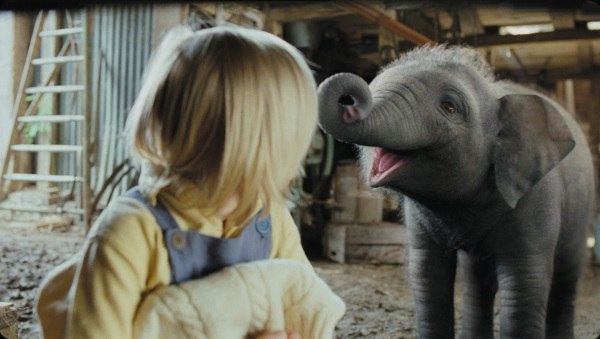Framestore goes photoreal with its creatures and whips up a magic harvest.
Check out the Nanny McPhee Returns trailer at AWNtv!
Nanny McPhee (Emma Thompson) is back with more tricks to fight World War II and to keep spoiled kids in line like a demented Mary Poppins. And the Susanna White-directed sequel required more elaborate vfx from Framestore, under the supervision of Christian Manz.
"All the creatures had to be photoreal and the director wanted you to almost believe that a pig climbs a tree and then does a synchronized swim in a pond with his mates," suggested Manz.
The 350 shots included 250 CG ones of McPhee's putty eating jackdaw, Mr. Edelweiss, the climbing and swimming pigs and a baby elephant. This required some look development for the pig and bird to get the right photoreal look. All the creatures were animated in <Maya> and <Mudbox>; and they created proprietary muscle rigs and then used the fRibgen bridge to take into <RenderMan>. All compositing was done in <Nuke>, which is a recent addition to the pipeline.
Mr. Edelweiss was definitely the most complicated creature. As with the pigs, two trained birds were used in as many shots as possible, so the CG match had to be correct. In addition, the bird is frequently seen folding or unfolding its wings, making for a far greater technical challenge, requiring a new feather system built as a Maya plug-in.
There are around 50 CG jackdaw shots, entailing R&D, rigging, grooming and animation, which took six months' work. Although the initial brief was for a photo-real bird, as the work developed, the production team realized that Framestore's bird had serious sidekick potential. So, Animation Supervisor Kevin Spruce (now head of animation) and his team added some subtle comedic grace notes to his animated performance. Thompson also provided reference for the way she thought the bird should behave, going as far as to film a physical performance to help guide the animators.
"We were still animating till the very end, but luckily because we had put so much work up front into the build of our creatures and the development of the feathers and rigging of Mr. Edelweiss, putting them into shots was quite quick," observes Manz. "This was the new model that we're trying to do for all of our shows now, which is keep stuff small at the beginning and then getting a bigger team at the end to get it done."
Meanwhile, the pigs posed their own challenges. "Kevin and his team did animation tests for the pigs' synchronized swim and run up the tree and along the branch (and some bird reference). Instead of doing traditional previs, what was more useful was to see what the animals would be able to do since you're filming empty plates."
The complementary water interaction and water vfx was tailor-made to fit the animation, and there was no time for further tweaking. The pond's pure CG water surface was created in <Houdini>, utilizing both 3D and 2D simulation, enhanced with filmed elements shot specifically by Manz at Shepperton.
The CG elephant was a last minute replacement because the real baby elephant suddenly died. A deceptively small part, yet the mechanics involved in getting an elephant convincingly up a flight of stairs and into bed were not easy under the time constraints.
The film's climactic vfx sequence takes place in a field, with Nanny McPhee standing in its center magically guiding the vital harvest of barley up into the air, where it swirls into a huge flock of starlings, forming into a series of creatures before bursting like a firework display and descending on the stunned humans below. Under the leadership of CG Supervisor Chris Lawrence, a team of six created the magical harvest as an animation-driven flocking simulation within Houdini.
"The magical harvest was always storyboarded, but nobody knew what it looked like," Manz suggests. "I think the final storyboards for that were five weeks before the end of delivering the film, so that was a huge undertaking. We had to come up with a way to efficiently simulate all of that flocking. We wanted to give the director the ability to direct the animals' shapes, so we came up with the system where they could direct an animated creature and we turned it into barley afterwards. The animals were animated in base particles with simulation dress up. The brief for them was that they would look like flocking starlings, so we found reference for them and the almost unreal shapes they create in the sky for real. I would say that was the most challenging sequence, particularly as that's the climax of the film."
Bill Desowitz is senior editor of AWN & VFXWorld.










